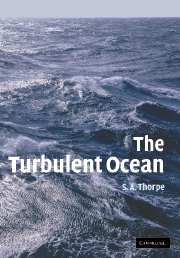Book contents
- Frontmatter
- Contents
- Preface
- Structure and résumé
- Acknowledgements
- 1 Heat, buoyancy, instability and turbulence
- 2 Neutral stability: internal waves
- 3 Instability and transition to turbulence in stratified shear flows
- 4 Convective instabilities
- 5 Instability and breaking of internal waves in mid-water
- 6 The measurement of turbulence and mixing
- 7 Fine-structure, transient-structures, and turbulence in the pycnocline
- 8 The benthic boundary layer
- 9 The upper ocean boundary layer
- 10 Shallow seas
- 11 Boundary layers on beaches and submarine slopes
- 12 Topographically related turbulence
- 13 Large-scale waves, eddies and dispersion
- 14 Epilogue
- Appendices
- References
- Index of laboratory experiments
- Subject index
- Plate section
6 - The measurement of turbulence and mixing
Published online by Cambridge University Press: 05 June 2012
- Frontmatter
- Contents
- Preface
- Structure and résumé
- Acknowledgements
- 1 Heat, buoyancy, instability and turbulence
- 2 Neutral stability: internal waves
- 3 Instability and transition to turbulence in stratified shear flows
- 4 Convective instabilities
- 5 Instability and breaking of internal waves in mid-water
- 6 The measurement of turbulence and mixing
- 7 Fine-structure, transient-structures, and turbulence in the pycnocline
- 8 The benthic boundary layer
- 9 The upper ocean boundary layer
- 10 Shallow seas
- 11 Boundary layers on beaches and submarine slopes
- 12 Topographically related turbulence
- 13 Large-scale waves, eddies and dispersion
- 14 Epilogue
- Appendices
- References
- Index of laboratory experiments
- Subject index
- Plate section
Summary
Introduction
Woods' method of studying the breaking of internal waves using divers to photograph dye movements described in Section 3.1 was constrained by weather, limited to the working depth of divers, and confined to scales of order 20 m because of the rapid attenuation of underwater visibility. It was soon recognized that a more thorough, quantitative investigation was required to observe and record the small-scale temperature and velocity structure of the water column, whilst insulating instruments from extraneous vibrations such as those induced by waves or ships' engines.
The first documented measurements of turbulence within the thermocline were published at almost the same time as Woods' observations. They were made by Grant et al. (1968) off the west coast of Vancouver Island using hot film anemometers mounted on a submarine. Turbulence was found to be continuous in the mixed layer at 15 m depth, with measured mean values of the turbulence dissipation rate, ε, of 2.5 × 10g−6 W kg−1 estimated by fitting the observed one-dimensional spectra to the theoretical spectrum (1.14). The rate of loss of temperature variance, χT, was 5.6 × 10−7 K2 s−1. In and below the seasonal thermocline, turbulence was patchy with mean values, ε = 1.5 × 10−8 W kg−1 and χT = 7.2 × 10−8 K2 s−1, at 90 m depth.
Except in boundary layers, such ‘patchiness’ has proved to be a usual characteristic of oceanic turbulence.
- Type
- Chapter
- Information
- The Turbulent Ocean , pp. 172 - 189Publisher: Cambridge University PressPrint publication year: 2005
- 1
- Cited by



